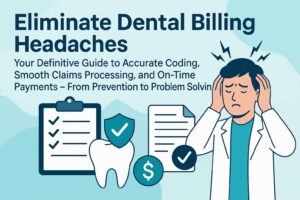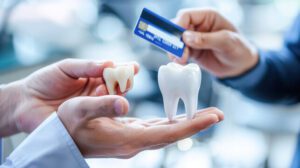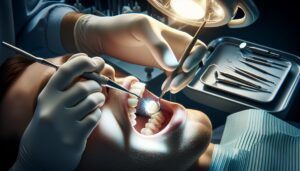The traditional methods of attracting new patients are no longer sufficient to stay competitive in the dental industry. Inbound marketing has emerged as a powerful strategy to gain new dental patients, offering a more effective and patient-centric approach. This shift in dental marketing strategies has revolutionized the way dental practices connect with potential patients and grow their businesses.
As we enter 2024, dental practices must adapt to the changing landscape of dental internet marketing to thrive. This article explores various aspects of inbound marketing for dentists, including the importance of a well-designed dental website, creating engaging content, optimizing for search engines, and leveraging patient reviews. By implementing these dental marketing ideas, dentists can enhance their online presence, attract more patients, and build lasting relationships with their existing clientele.
Each type of plan has its advantages and disadvantages, and the choice between them often depends on individual patient needs and preferences. Dental practices must navigate these options carefully, considering both business goals and patient care standards. Outsourcing complex billing processes to specialized companies like One Dental Billing can help practices manage the intricacies of different insurance plans, ensuring they maximize their revenue while providing optimal care to patients.
The Shift to Digital: Why Inbound Marketing Matters for Dentists
In the rapidly evolving landscape of dental marketing, the shift to digital strategies has become increasingly crucial for dental practices seeking to attract and retain patients. This transformation has been driven by changing patient behaviors and expectations, as well as the growing influence of technology in healthcare.
Traditional vs. Inbound Marketing
Traditional marketing methods for dentists have typically included radio ads, direct mail, billboards, and local television commercials. These approaches involve substantial upfront costs and rely on reaching a broad audience in hopes of connecting with potential patients . However, this shotgun approach often results in wasted resources and limited targeting capabilities.
In contrast, inbound marketing for dentists focuses on creating valuable content and experiences tailored to the specific needs and interests of potential patients. This patient-centric approach utilizes digital channels such as websites, search engines, and social media to attract and engage individuals actively seeking dental care information .
The effectiveness of inbound marketing is evident in the statistics:
These figures underscore the importance of having a strong digital presence and implementing effective inbound marketing strategies.
The Modern Patient’s Journey
Today’s dental patients are tech-savvy and expect convenience in their healthcare experiences. They desire the ability to schedule appointments online, receive friendly reminders, and access information easily . Practices that offer a modern, digital-first experience are better positioned to attract new patients and build stronger relationships with existing ones.
Key aspects of the modern patient’s journey include:
- Online research: 48% of patients conduct over two weeks of research before scheduling an appointment .
- Local search: 46% of all Google searches are seeking local information .
- Mobile accessibility: 44% of patients who find healthcare providers through mobile search go on to schedule an appointment .
- Online booking: 77% of patients prefer providers offering online booking and scheduling services .
To cater to these preferences, dental practices should consider implementing the following strategies:
- Develop a user-friendly, mobile-responsive website
- Optimize their Google Business Profile
- Offer online scheduling capabilities
- Provide educational content through blog posts, videos, and social media updates
- Showcase patient testimonials and reviews
- Utilize patient engagement tools for automated communication and feedback
By embracing inbound marketing techniques, dental practices can establish themselves as trusted authorities in dental care. This approach focuses on creating quality content, leveraging patient testimonials, and fostering robust digital interactions . Unlike short-term marketing tactics, inbound marketing helps build a loyal patient base that views the practice as a leading authority in dental care.
In conclusion, the shift to digital marketing strategies is essential for dental practices looking to thrive in today’s competitive landscape. By understanding and adapting to the modern patient’s journey, dentists can effectively attract new patients and cultivate long-lasting relationships with their existing clientele.
Building a Patient-Centric Website
A dental practice’s website is often the first point of contact for potential patients, making it a crucial marketing tool . To create an effective online presence, dentists must focus on developing a patient-centric website that caters to the needs and expectations of their target audience.
User Experience Best Practices
To ensure a positive user experience, dental websites should prioritize the following elements:
Intuitive Navigation: 94% of respondents in a 2022 survey identified easy navigation as the most important website feature . Visitors should be able to effortlessly find information about services, pricing, and contact details.
Mobile Responsiveness: With 97% of Americans owning a smartphone and an increasing number using them as their primary device for internet access, mobile optimization is crucial . A responsive design that adapts to different screen sizes enhances accessibility and user experience.
Fast Loading Times: Website speed has a significant impact on user experience and search engine rankings. Implementing adaptive design can lead to faster loading times, which is particularly important in the competitive dental industry .
Clear Call-to-Action: Provide easily accessible contact options, such as a prominent “Call Now” button, to facilitate patient engagement .
Engaging Content: Utilize high-quality images, informative videos, and well-written copy to educate patients about services and showcase the practice’s expertise .
Staff Bios: Including information about providers and staff can help patients feel more connected to the practice .
Educational Blog: A well-written blog can demonstrate the practice’s knowledge and expertise, helping to build trust with potential patients .
Each type of plan has its advantages and disadvantages, and the choice between them often depends on individual patient needs and preferences. Dental practices must navigate these options carefully, considering both business goals and patient care standards. Outsourcing complex billing processes to specialized companies like
One Dental Billing can help practices manage the intricacies of different insurance plans, ensuring they maximize their revenue while providing optimal care to patients.
Mobile Optimization
Given the prevalence of mobile device usage, optimizing a dental website for mobile is no longer optional. Here are key considerations for mobile optimization:
Responsive Design: Implement a responsive web design that adjusts content layout based on the device’s screen size . This approach ensures a consistent experience across all devices.
Touch-Friendly Elements: Design interface elements that are easy to interact with on touchscreens, such as larger buttons and simplified navigation menus .
Streamlined Content: Present information in a concise, easily digestible format suitable for smaller screens .
Fast Loading: Optimize images and code to ensure quick loading times on mobile networks .
Click-to-Call Functionality: Implement click-to-call buttons to make it easy for mobile users to contact the practice directly .
Local SEO: Optimize for local search results, as 46% of all Google searches are seeking local information .
By focusing on these user experience best practices and mobile optimization strategies, dental practices can create websites that not only attract new patients but also provide a seamless experience for existing ones. A well-designed, patient-centric website serves as a powerful tool for dental marketing, helping practices stand out in the competitive digital landscape.
Crafting Compelling Content for Dental Audiences
In the digital age, creating engaging content is crucial for dental practices to attract and retain patients. By focusing on educational blog posts and engaging social media content, dentists can establish their expertise, build trust, and connect with their target audience effectively.
Educational Blog Posts
Dental care blogs play a vital role in a practice’s marketing strategy. They not only provide valuable information to patients but also increase brand awareness, attract new patients, and ensure accurate information dissemination. Additionally, blogs are essential for boosting search engine optimization (SEO), as search engines reward websites that offer fresh content for indexing .
To create effective dental blogs:
Maintain consistency and style: Publish blogs regularly, at least twice a month, with posts ranging from 300 to 600 words .
Focus on patient-centered content: Address common questions about dental care and provide educational information that attracts prospective patients .
Discuss new equipment and treatments: Inform patients about the latest technology and procedures available at the practice .
Incorporate seasonal content: Tie blog topics to life events, seasons, or holidays to make them more relatable and timely .
Include calls-to-action (CTAs): Place CTAs toward the end of blog posts to encourage readers to schedule appointments .
To enhance the effectiveness of dental blogs, consider the following tips:
- Use simple, easy-to-read language and avoid technical jargon .
- Incorporate personal elements to help patients feel more at ease with the practice .
- Provide actionable steps and practical advice for readers .
- Use data and case studies to support main arguments .
- Consider adding visual aids or short videos to clarify concepts .
Engaging Social Media Content
Social media platforms play a crucial role in dental marketing strategies, helping practices build an online presence and connect with potential patients. To create an effective social media strategy, dentists should focus on the following:
Utilize multiple platforms: Facebook, Instagram, and YouTube are the top three social media channels for dental marketing .
Leverage various content formats:
- Facebook: Use ads, live broadcasts, and regular posts to engage audiences .
- Instagram: Share visually appealing content and utilize Instagram Stories .
- YouTube: Create video content such as office tours, procedure demonstrations, and staff introductions .
Diversify content types:
- Share patient reviews and testimonials to build trust .
- Post practice updates and milestones .
- Offer dental health and hygiene tips .
- Share interesting dental facts .
- Provide information about dental services .
- Organize contests and giveaways to increase engagement .
Use captivating visuals: Incorporate high-quality images and videos to showcase expertise and create a positive impression .
Tell stories: Use captions to create narratives that bring images to life and showcase the practice’s role .
Create evergreen content: Develop posts that retain their value over time, such as patient testimonials, dental education, and DIY tips .
Prioritize video content: Audiences are more likely to engage with video content, making it an essential component of social media strategies .
By focusing on creating educational blog posts and engaging social media content, dental practices can effectively attract new patients, build trust, and establish themselves as authorities in dental care. This approach not only improves online visibility but also fosters stronger relationships with both potential and existing patients.
Harnessing the Power of SEO for Dental Practices
Search Engine Optimization (SEO) has become a crucial strategy for dental practices to improve their online visibility and attract new patients. SEO helps dental websites rank higher in search engine results pages (SERPs) without relying on paid advertising . This organic approach not only builds trust with potential patients but also creates a positive cycle of increased visibility and credibility .
On-Page SEO Techniques
On-page SEO involves optimizing individual web pages to rank higher and earn more relevant traffic in search engines . Here are some essential on-page SEO techniques for dental practices:
Keyword Optimization: Incorporate relevant keywords throughout the website content, including the title tag, meta description, H1 tag, and body text .
Content Quality: Create compelling, helpful, and people-first content that addresses patients’ needs and concerns .
Page Structure: Use semantic HTML and proper heading tags (H1, H2, H3) to help search engines understand the content structure .
Internal Linking: Build a strong internal linking strategy to connect related pages on the website, helping search engines crawl and index the site more effectively .
Page Speed Optimization: Improve website loading times, as 40% of visitors abandon sites that take more than 3 seconds to load .
Mobile Optimization: Ensure the website is mobile-friendly, as this has become increasingly important for SEO rankings .
By implementing these on-page SEO techniques, dental practices can enhance their website’s visibility and provide a better user experience for potential patients.
Building Quality Backlinks
Off-site SEO, particularly building quality backlinks, has a significant impact on a dental practice’s search engine rankings . Backlinks are links from other websites that point to your dental practice’s website. Here are some effective strategies for building quality backlinks:
Local Citations: Claim and optimize your Google Business Profile and other local business directories to improve local SEO .
Content Creation: Develop link-worthy content, such as informative blog posts, research studies, or useful videos that other websites in the dental industry might want to share .
Guest Blogging: Write guest posts for reputable websites in the dental or healthcare industry to earn high-quality backlinks .
Community Involvement: Sponsor local events, participate in charity work, or collaborate with schools and local businesses to earn backlinks from community websites .
Professional Networks: Leverage professional and personal networks, such as college alumni associations or local dental conferences, to gain backlinks .
Press Releases: Publish press releases about your practice’s participation in local events or charitable activities to gain local coverage and backlinks .
Patient Reviews: Encourage patients to leave online reviews, which can generate backlinks from review platforms .
Broken Link Building: Identify broken links on other websites and offer your content as a replacement .
By focusing on both on-page SEO techniques and building quality backlinks, dental practices can significantly improve their search engine rankings, increase online visibility, and attract more potential patients to their websites.
Email Marketing: Nurturing Patient Relationships
Email marketing has become an essential tool for dental practices to communicate directly with patients, fostering stronger relationships and improving patient retention. By leveraging personalized messages, appointment reminders, and valuable content, dental offices can create a sense of care that extends beyond the dental chair .
Segmentation Strategies
Effective email marketing begins with understanding the audience. Segmentation involves dividing the email list into smaller groups based on specific criteria, allowing for more targeted and relevant content . Here are some key segmentation strategies for dental practices:
Demographics: Divide patients based on age, gender, and income level. This allows for tailored messages, such as focusing on denture care for seniors or braces for teenagers .
Patient Needs: Segment based on specific dental services of interest, such as pediatric dentistry or cosmetic procedures .
Communication Preferences: Some patients prefer informational content, while others might be more interested in promotional offers .
Geographic Location: For practices with multiple locations, geographic segmentation ensures that emails are relevant based on the patient’s location .
Behavioral Patterns: Analyze appointment history and service preferences to send targeted follow-up emails or reminders .
Psychographic Factors: Consider patients’ values and attitudes toward dental health, which can be collected through surveys or social media interactions .
By implementing these segmentation strategies, dental practices can create more personalized and engaging email campaigns that resonate with their patients.
Each type of plan has its advantages and disadvantages, and the choice between them often depends on individual patient needs and preferences. Dental practices must navigate these options carefully, considering both business goals and patient care standards. Outsourcing complex billing processes to specialized companies like One Dental Billing can help practices manage the intricacies of different insurance plans, ensuring they maximize their revenue while providing optimal care to patients.
Personalized Email Campaigns
Personalization goes beyond simply addressing the recipient by name. It involves tailoring content to meet specific needs and interests of each patient segment . Here are some effective personalization strategies:
Targeted Content: Provide educational material that empowers patients to prioritize their oral health. This can include tips for preventing cavities, proper teeth cleaning techniques, and recommended dental routines .
Appointment Reminders: Use automated workflows to send timely appointment reminders, reducing the likelihood of no-shows .
Special Offers: Send personalized promotional emails based on treatment history. For example, if a patient recently inquired about teeth whitening, follow up with a special offer on that service .
Follow-up Communications: After appointments, send follow-up emails to express gratitude, inquire about the patient’s experience, and provide any necessary post-treatment instructions .
Feedback Requests: Use email marketing to gather patient feedback through surveys and reviews, showing patients that their opinions are valued .
New Patient Onboarding: For new patients, focus on introductory offers or services like free consultations .
By implementing these personalization strategies, dental practices can significantly enhance the relevance and impact of their email campaigns. Personalized email campaigns have been shown to increase open rates by 14% and click-through rates by 10% .
To execute a successful email marketing strategy, dentists should build a responsive email list by encouraging patients to subscribe through the clinic’s website, during appointments, or through social media . By providing valuable and relevant content, dental practices can keep patients engaged and eager to receive regular updates, ultimately strengthening patient relationships and improving overall oral healthcare outcomes.
Leveraging Patient Reviews and Testimonials
Patient reviews and testimonials have become a crucial component of dental marketing strategies. With approximately 72% of patients reading online reviews as their first step when seeking a new doctor, and 69% considering positive reviews of utmost importance when selecting a healthcare provider, including dentists, it’s clear that online reputation has a significant impact on patient acquisition . In fact, 43% of patients are willing to go to an out-of-network provider solely based on good reviews .
Encouraging Positive Reviews
To harness the power of patient reviews, dental practices should actively encourage patients to share their experiences. Here are some effective strategies:
Automated Requests: Implement email and SMS texting services to ask patients for reviews directly after their appointments. Include direct links to review sites for convenience .
In-Office Promotion: Display physical signs in the office communicating the importance of reviews to the practice. This reminds loyal patients to share their experiences .
Staff Training: Train staff to ask patients about their appointment experience before they leave. If positive, invite them to leave a review .
Social Media Check-Ins: Encourage patients to check-in on social media or review platforms during their visit. Display signage in the waiting room and have staff remind patients about check-ins .
Incentives: Consider offering small incentives such as discounts on future appointments or dental products to encourage patients to leave reviews .
Follow-Up Communications: Include review requests in appointment reminder emails or texts, and follow up with patients after treatments or procedures to ask about their experience and request a review .
By implementing these strategies, dental practices can increase the number of positive reviews, enhancing their online reputation and attracting new patients.
Responding to Feedback
Responding to patient reviews, both positive and negative, has become an essential aspect of dental practice management. Here’s why it matters and how to do it effectively:
Importance of Responses: Responding to reviews shows that the practice values patient input and is committed to delivering a positive experience. It increases the likelihood that patients will give the practice another chance, with more than two-thirds of patients who left negative reviews saying they would return if the practice responded to their complaint .
Guidelines for Responding:
- Thank the patient for their feedback, regardless of whether it’s positive or negative .
- Respond courteously without apologizing, as an apology can be viewed as an admission of guilt .
- Keep responses brief and professional .
- Avoid using protected health information (PHI) or any language indicating the reviewer has been a patient .
- Provide contact information to take the conversation offline .
Handling Negative Reviews:
- Never ignore honest reviews, especially negative ones .
- Address concerns directly using company policy. For example, if a patient mentions long wait times, state that the practice aims to see all patients on time .
- Encourage the reviewer to reach out directly to the practice, allowing for issue resolution and moving the conversation offline .
Positive Review Responses:
- Thank the reviewer for sharing their thoughts .
- Remind the reviewer that a positive experience is your top focus .
- Include one targeted keyword or phrase (e.g., business name, location, products, or services) to support SEO optimization .
By effectively managing patient reviews and testimonials, dental practices can build trust, improve their online reputation, and ultimately attract more patients. Remember, reviews are like teeth: they must be actively cultivated and cared for to maintain a healthy practice image .
Conclusion
To wrap up, inbound marketing has become a game-changer for dental practices looking to attract new patients in 2024. By focusing on creating a patient-centric website, crafting compelling content, and harnessing the power of SEO, dentists can establish a strong online presence that resonates with their target audience. These strategies, combined with effective email marketing and leveraging patient reviews, create a holistic approach to dental marketing that builds trust and fosters long-lasting relationships with patients.
As the dental industry continues to evolve, embracing these digital marketing techniques is crucial for practices to stay competitive and grow their patient base. By implementing these strategies, dentists can not only improve their online visibility but also enhance the overall patient experience. This approach to dental marketing has a significant impact on practice growth, helping dentists to thrive in an increasingly digital healthcare landscape.
Each type of plan has its advantages and disadvantages, and the choice between them often depends on individual patient needs and preferences. Dental practices must navigate these options carefully, considering both business goals and patient care standards. Outsourcing complex billing processes to specialized companies like One Dental Billing can help practices manage the intricacies of different insurance plans, ensuring they maximize their revenue while providing optimal care to patients.
FAQs
1. How can a new dentist effectively market their practice?
To effectively market yourself as a new dentist, begin by identifying your target audience. Implement competitive marketing campaigns and set up a referral bonus system to encourage word-of-mouth. Enhance your online presence through digital promotions, search engine optimization (SEO), and email marketing. Additionally, consider advertising through Google Ads and Facebook to reach a broader audience.
2. What is the most effective marketing strategy for dental practices?
The most effective marketing strategy for dental practices is word-of-mouth marketing. Ensuring that patients have exceptional experiences at your clinic will make them likely to recommend your services to their friends, family, and colleagues, thereby naturally promoting your practice.
3. Is the dental services market expected to grow?
Yes, the dental services market is projected to grow significantly. From a valuation of USD 147.3 billion in 2022, it is expected to reach approximately USD 295.23 billion by 2032, with a compound annual growth rate (CAGR) of 7.2% from 2023 to 2032.
4. What does the future look like for dentists in terms of job growth?
The job growth rate for dentists is expected to be around 4% from 2022 to 2032, aligning with the average growth rate for all occupations. This indicates a steady demand for dental professionals in the coming years.



















